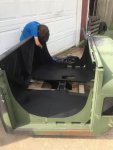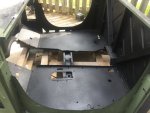- 18,541
- 5,852
- 113
WOW! IF that's true, I'd like to see the MSDS (Material Safety Data Sheet) on the CARC product.
From my experience as an Aviation Avionics and Electrical Design Engineer:
For years the FAA "thought" by virtue of a wire manufacturing competitor's rumor that TEFLON INSULATED WIRE for aircraft would off-gas CYANIDE in a fire and therefore was threatening to ground ALL aircraft already certified as airworthy if ANY single wire onboard was TEFLON INSULATED. This would have had MULTI-BILLION DOLLAR ramifications on the entire aviation world. At that point there were MANY aircraft equipped with entire wire harnesses of this wire, largely favored by aircraft manufacturers because of it's lighter weight, comparatively smaller outside diameter for equal gauge strands otherwise insulated, higher abrasion resistance, and other favorable factors. Even when presented with the chemical formulations PROVING that those chemicals necessary to generate CYANIDE GAS simply and ABSOLUTELY were NOT PRESENT in the TEFLON PRODUCT, the "all-knowing" FAA still for many months/years perpetuated the FALSE RUMOR that TEFLON INSULATED WIRES involved in even the most minor fire would KILL everyone onboard the aircraft. As I recall, this "scandal" was finally squashed by a (threat of??) lawsuit including CIVIL PENALTIES for the persons refusing to acknowledge the science and TRUTH of the matter.
Just imagine if this was true about teflon. How many cooks have burned dinner while cooking in Teflon coated cookware?!?!?!?!? We'd ALL be dead by now!!!
Hence, while CARC is a very different composition than Teflon, PLEASE confirm whether this is FACT or MALICIOUS RUMOR before perpetuating this alarming claim.
Thank you.
WHEW!!!71DeuceAK, dunno where ya got the cyanide intel but it is false. The "guilty" parties in the dust / fumes are isocyanates ( think super glue ). This is what makes this coating stick "like glue" and be "tough as nails". Dupont had a similar (chemically) product under the Imron brand. Beautiful finish, hard as granite, deadly if inhaled or absorbed ( usually through the eyes or other mucus memebranes ). The primer was known "affectionately" as YELLOW DEATH. Also potentially deadly via the same routes during abrasion, stripping, or other means of removal.
The GOOD news : if it's in good shape, there isn't a better surface on the planet to paint over. As noted above, clean, no bare metal ( prime with epoxy ), and a little rough ( it's normal state is perfect, or roughen with 320 if shiny ). Once those conditions are met, spray, roll, brush, throw whatever you want on it.
We dodged that CYANIDE bullet, didn't we ?!?!?
It's a worthy education and I'm glad we have chased this rabbit (and assassinated it). It always feels good when the truth prevails, rumors are quelled, and we all become just a little smarter for the experience.

If anyone is interested in a little deeper education, here are some WIKI's on the ISOCYANATE and CYANIDE differences and their associated yet VERY DIFFERENT toxicities.
ISOCYANATE:
https://en.wikipedia.org/wiki/Isocyanate
ISOCYANATE's HAZARDS (LOW Toxicity):
https://en.wikipedia.org/wiki/Isocyanate#Hazards
Versus
CYANIDE:
https://en.wikipedia.org/wiki/Cyanide
CYANIDE's TOXICITY (HIGHLY TOXIC in many forms):
https://en.wikipedia.org/wiki/Cyanide#Toxicity
These links are interesting reading if you're into chemistry, reading that will make you sleepy, and most importantly - THINGS THAT MAY ONE DAY SAVE YOUR LIFE!!!!
Carry on.... and don't forget to wear your PPE (Personal Protective Equipment).



 But the YELLOW DEATH thing was really hammered home when a friend almost died from spraying it the same way he sprayed lacquer at the time. PPE was flip-flops, shorts, and a Hawaiian shirt.
But the YELLOW DEATH thing was really hammered home when a friend almost died from spraying it the same way he sprayed lacquer at the time. PPE was flip-flops, shorts, and a Hawaiian shirt.
